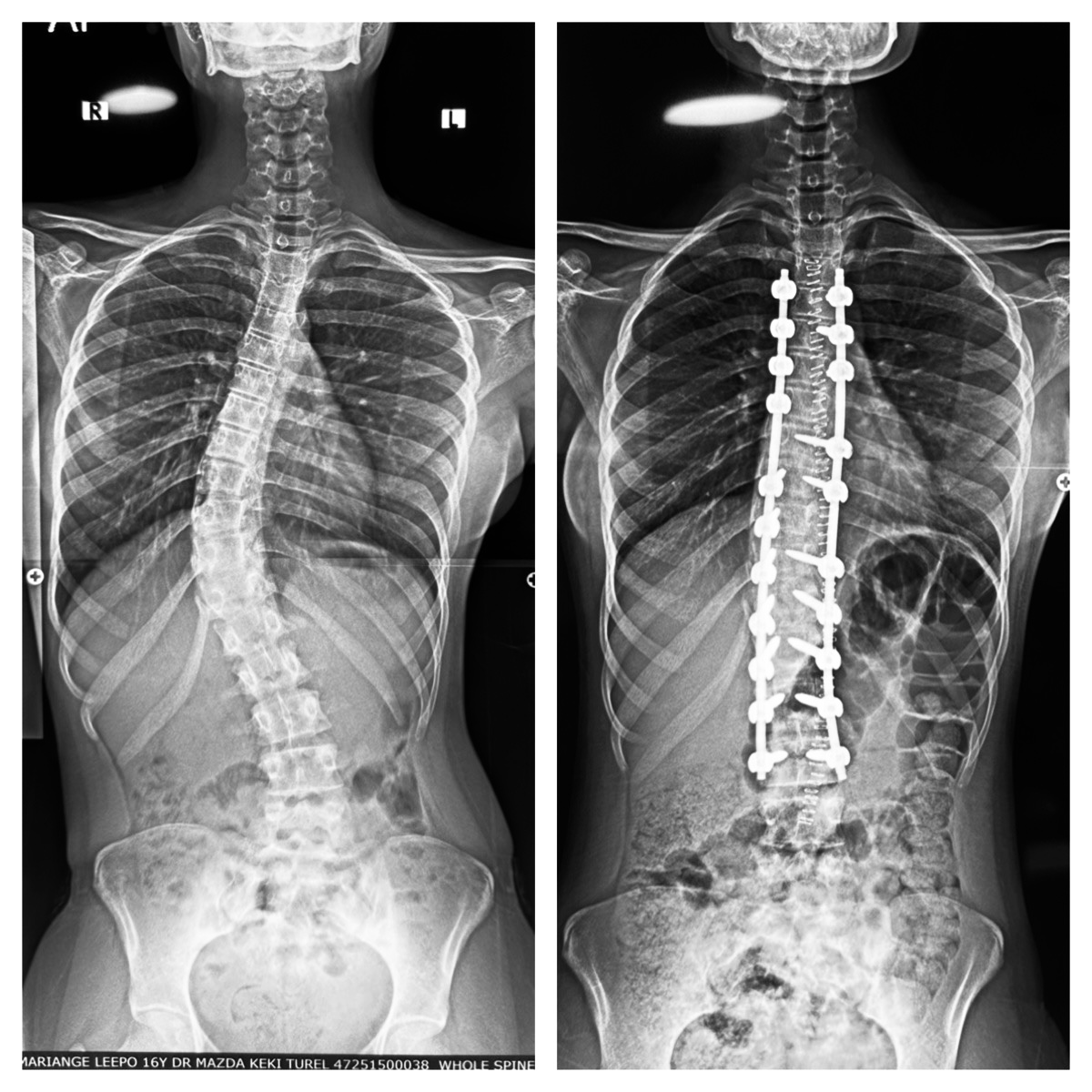Faced with a teen living with severe scoliosis, surgery proves the best way to give her the chance to stand tall, both literally and metaphorically
She walked into my office with the awkward grace of a 16-year-old – lanky limbs, a schoolbag slung off one shoulder, and a smile that was equal parts shy and mischievous. Her mother followed, sari pleats in place, handbag clutched like a shield, her expression already rehearsed in worry.
“Doctor,” the girl said, before her mother could start, “my back is crooked.” Her mother sighed. “She’s complaining of pain when she sits too long, and sometimes her friends tease her because her blouse doesn’t sit right.” I asked her to stand straight. She did, gamely. From behind, the curve was unmistakable; her spine swaying to one side like a reluctant dancer, pulling her shoulders and hips out of line. It was scoliosis – the kind that doesn’t just bend the body but also bends the confidence of a teenager learning how to occupy her own skin. She laughed when I asked her if she had trouble carrying her bag. “No, Doctor,” she said, “I just tell my brother to carry it for me.” It was sixteen going on sixty: she had already learnt the art of delegation.
Scoliosis is a three-dimensional deformity of the spine, most often showing up during adolescence. Instead of the spine standing tall and straight, it curves sideways, sometimes like a gentle arc, sometimes like an exaggerated question mark. For some it causes pain, for others difficulty in breathing, and for many, just the daily discomfort of being bent out of shape – physically and socially. When the curve is mild, we watch and wait, sometimes adding braces. But when it grows severe, surgery is the only way to set things right. Surgery doesn’t just correct posture; it realigns the body’s balance, prevents future complications, and very often gives back to a teenager the chance to stand tall, both literally and metaphorically.
Her scans showed thoracolumbar scoliosis from T4 (the fourth thoracic vertebra) to L3 (the third lumbar vertebra) – 12 levels of deformity. That’s almost the whole length of her visible spine, from the base of her neck down to her lower back. It wasn’t going to straighten itself. Every scoliosis case is a learning curve – in geometry, patience, and humility.
On the morning of surgery, she was wheeled in looking smaller than she had in my clinic. Anaesthesia eased her to sleep. We turned her prone, carefully padded, her back exposed like a canvas waiting for correction. Through a midline incision, we exposed the spine from T4 to L3. Each vertebra was identified, and we placed screws with the precision of threading beads into a necklace. On one side of the curve, rods were fixed and gently rotated, gradually de-rotating the twisted vertebrae. On the other, the rod was fixed to balance the pull. The spine, which had curved like a bowstring, began to straighten under steady, controlled force.
Bit by bit, vertebra by vertebra, the arc dissolved. The correction was not just mechanical; it was aesthetic. A back that had once looked tilted now looked symmetrical. Shoulders levelled. A waistline returned. Even under drapes and monitors, you could sense the transformation. After tightening every screw, locking every rod, and checking alignment, we closed the incision in layers. What had been a crooked silhouette was now as straight as nature had originally intended.
She woke up groggy, immediately asked for her mother, and then, with teenage priorities intact, asked for her phone. Pain management was critical in the days that followed, but her smile returned quickly. On day three, she stood up, her posture a revelation. “I look taller!” she declared, delighted. Her mother nodded, tears balancing on her lashes. There was just one problem: she hadn’t passed stool since the surgery. Painkillers and immobility can slow the bowels to a stubborn halt. By day five, the whole ward knew she was waiting. By day seven, just before discharge, it happened — a massive potty, so triumphant that she announced it like a board exam result. “Doctor,” she said, glowing with relief, “now I feel truly light.”
Curves define us more than we admit. There are curves in spines, in roads, in relationships, in stories, even in careers. Some curves throw us off balance, while some steady us. For surgeons, every patient is part of a larger learning curve that teaches us restraint, precision, and the courage to straighten what seems unstraightenable. For patients, especially teenagers, the curve can become a shadow, bending self-image and self-esteem. Correcting it is not just surgery; it is, in a sense, psychology.
This patient reminded me that surgery is about more than angles and screws. It is about letting a girl walk along a college corridor without feeling that her body has betrayed her. It is about giving her the chance to stand tall in family photographs, letting her shoulders and spirit line up with each other again.
She left the hospital ten days later, her gait steady, her smile brighter, and her mother visibly taller too, her shoulders free of years of worry. In the end, the curve in her spine had been straightened, the curve of her journey had bent towards joy, and my own learning curve had moved a bit further in the right direction.
Sometimes surgery is about saving lives. Sometimes it is about saving the simple joy of standing straight. And occasionally, it is about making sure a 16-year-old has both a straighter spine and a spectacular potty story to tell.





18 thoughts on “The Surgical Curve”
Every article you write, Maz, has me holding my breath, waiting outside your operating room, for the declaration of the outcome!
I was struck with the incident presented today, not simply because it is fascinating that an entire spine could be asked to toe a line at the hands of our skilful surgeon, but also that spine with its precious contents could indeed be coerced to give back the joy to the teenager!
👏🏻👏🏻👏🏻
Hi very happy to read on spinal deformity rightly written thanks again and again for such a wonderful write up 💓 💐💐💐💐
Thank you for this insightful article. I’ve had this same surgery at the hands of Dr Johari 25 years ago. It’s nice to read about the surgeons pov
Hiya Doc… after having consulted with some super big boys in your profession, I’m so glad I chose you for my brain surgery and to be under your care… inspite of you being the youngest of them all, you surpassed my expectations with flying colours… I recall my first consultation with you, like it was yesterday… needless to say, you’re not just a genius in what you do best, but also gifted in abundance…
Just please stay the way you are, humble and humane… keep shining and smiling, incredibly radiant !!
Also know that I’m doing well and rocking today, all thanks to you !
Will always remain grateful 🥲
I admire the precision in language, description, humour, scientific information and also the realism in your writings.
I look forward to your books in future.
Many thanks.
Beautifully written as always. From crooked spines to straightened lives. However, I suspect that the patient will remember her ‘record-breaking potty’ just as fondly as the surgery 🙃
Feels great to read a story of success and satisfaction…both for the patient and doctor… especially with regards to a scoliosis surgery which entails skill, precision, risk of neurological complications and blood loss….lucidly described to bring out the essence of a difficult case. …cheers to you dr mazda
Great doctor Mazda 👏 bless the teenager who approached a great surgeon like you who did a tremendous & marvelous surgery with great precession & made her life easy going.
God bless you to Dr. Mazda 👍👌👌
” her expression rehearsed in worry”….wow! What an apt description! I read your articles not just for the spine stories but also the rich language!!!
Love and look forward to reading them!!
At 85 I have a curved spine which is making me quite stooped.. was diagnosed with spinal stenosis, I train at home quite regularly, light exercises wilth Great Expectations ..can I straighten my spine with focused exercises?..
The surgical stabilization with fixed screws and connecting rods is nothing but a catastrophe!
The normal.mobility of the spine is lost and her future shall be dictated by analgesic addiction and depression due to pain and being incarcerated by a stainless steel structure inbedded with nails impeding any possibility of growth and adaptation!
She should have had inverted kinetic traction with strengthening of the the paraspinal.muscles.
Though results are not immediate with persistence of inverted traction and exercises over many years the natural adaptive growth of the body would improve the spine rather than an invading ” nails-in-the-spine” preventing any future plasticity the body be capable of!
PFMcDonald
The joy and passion of clinical artist is overwhelming,keep going doc
Standing tall wasnt just fr her
It was thru u fr each one bent with disbelief n rumours n fears about spinal surgeries… faith restored!! One patient at a time !
Long live Mazda!!! The doctor for patients in bad time !!
It is said that “A smile is a curve that sets everything straight.” And you, Doc, like a master puppeteer, have a way of straightening your patients’ curvy contours—effortlessly pulling just the right strings, yet keeping that smiling curve intact.
Dear Dr. Mazda,
I would like to express my sincere gratitude and deep appreciation for the valuable and beneficial knowledge you have shared, as well as for your dedicated efforts in treating patients. Your noble character and genuine humility truly set an inspiring example.
We have witnessed your commitment to both excellence in medicine and compassion towards your patients, embodying the true spirit of a physician who combines knowledge, skill, and humanity.
May Allah reward you abundantly, bless your efforts, and grant you continued success in your noble mission.
With heartfelt thanks and appreciation,
Sulaiman
I have been having serious pains down my lower back.Am in Nigeria but can’t afford the bills for surgery.
It gives me hot sensations and at times tingling.
I don’t know what to do.I can’t walk for minutes because of the excruciating pains. What do I do?
Hi Mazda, speaking on the lighter side your today’s piece revealed your skill in carpentry too ofcourse blended with your surgical skill.
This generation is truly blessed having Dr Mazda.
Dear Dr Mazda
Was again a really wonderful read
Could visualize the relief felt by the lady patient from so complicated a condition
Your simple description of what is for sure a complicated procedure almost gives a visual feel to what transpired
Thanks as always for sharing these experiences in so readable a manner
We will await the next
Regards